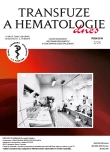Recruitment of stem cell donors to the Czech national marrow donor registry between 2013–2017 (demographic data)
Authors:
J. Navrátilová 1,2; P. Jindra 1,2,3; L. Houdová 4
Authors‘ workplace:
Hematologicko-onkologické oddělení FN Plzeň
1; Český Národní Registr Dárců Dřeně, Plzeň
2; Biomedicínské centrum, Lékařská fakulta v Plzni, Univerzita Karlova, Česká Republika
3; NTIS – Nové technologie pro informační společnost, Fakulta aplikovaných věd, Západočeská univerzita v Plzni
4
Published in:
Transfuze Hematol. dnes,25, 2019, No. 3, p. 252-257.
Category:
Original Papers
Overview
The Czech National Marrow Donors Registry (CNMDR) was established in 1992 to find an optimal "national" donor for Czech patients or to provide a donor from abroad as soon as possible. The current state of the CNMDR database (to October 31, 2018) stands at 83.000 donors and the median age of all active donors in the registry is 32 years. Given the transplant centres’ preference for younger donors and for economic reasons, the CNMDR reduced the maximum age limit for entry into the registry to 35 years in 2009. The aim of our work was to evaluate the success of this age restriction and general recruitment strategy focusing on young males and to evaluate the quantitative and qualitative recruitment parameters in 2013–2017. Between 2013 and 2017, the recruitment of new donors ranged from 5.000 to 10.000/year. In total, 36.720 donors were recruited during this period. Newly recruited donor gender distribution has been almost equally balanced in recent years. The average median age of recruited donors was 27 years. This massive recruitment of young donors led to a continuous reduction of the CNMDR database donor median age. The presented data clearly demonstrate the effectiveness of the current CNMDR recruitment strategy. In the past years, there has been a significant decrease in the donor age median as well as an increase in male donor contribution. This is in accordance with the preferences of transplant centres that prefer young donors especially males, based on published data. For this recruitment strategy to remain successful, the CNMDR will need to maintain its continued good cooperation with donor and recruitment centres as well as with volunteers.
Keywords:
recruitment – donors – registry
Sources
1. Jindra P. 25 let Českého národního registru dárců dřeně a Nadace pro transplantace kostní dřeně. Transfuze Hematol Dnes 2017;23 : 223–227.
2. World Marrow Donor Association WMDA International Standards for Unrelated Hematopoetic Stem Cell Donor Registries [online] [cit. 4.1.2017] Dostupné na www: https://share.wmda.info/display/ANON/WMDA+Standards?preview=/20748235/200048678/20160905-STDC-WMDA%20standards%20cleared%20version.pdf.
3. Sacchi N, Costeas P, Hartwell L, et al. Haematopoietic stem cell donor registries: World Marrow Donor Association recommendations for evaluation of donor health. Bone Marrow Transplant 2008;42(1):9–14.
4. Tiercy JM. How to select the best available related or unrelated donor of hematopoietic stem cells? Haematologica 2016;101(6):680–687.
5. Lown RN, Shaw BE. Beating the odds: factors implicated in the speed and availability of unrelated haematopoietic cell donor provision. Bone Marrow Transplant 2013;48 : 210–219.
6. Kollman C, Spellman SR, Zhang MJ, et al. The effect of donor characteristics on survival after unrelated donor transplantation for hematologic malignancy Blood 2016;127(2):260–267.
7. Billen A, Madrigal JA, Szydlo RM, et al. Female donors and donors who are lighter than their recipient are less likely to meet the CD34+ cell dose requested for peripheral blood stem cell transplantation. Transfusion 2014;54 : 2953–2960.
8. Jindra P, Sedláček P, Žák P. Optimální proces vyhledávání dospělého nepříbuzného dárce krvetvorných buněk. Doporučení Transplantační sekce České hematologické společnosti. Transfuze Hematol Dnes 2014;20 : 6–12.
9. Český statistický úřad. Náboženská víra obyvatel podle výsledků sčítání lidu. [online] [cit. 19.2.2019] Dostupné na www: https://www.czso.cz/documents/10180/20551795/17022014.pdf/c533e33c-79c4-4a1b-8494-e45e41c5da18?version=1.0.
Labels
Haematology Internal medicine Clinical oncologyArticle was published in
Transfusion and Haematology Today

2019 Issue 3
Most read in this issue
- Osteonecrosis of the jaw, atypical fractures and other less frequent adverse events associated with bisphosphonates
- Revaccination of adult patients following allogeneic haematopoietic stem cell transplantation: CELL recommendations
- Pharmacokinetics in haemophilia treatment
- Sirolimus – alternative treatment for warm antibody hemolytic anaemia (WAIHA)
